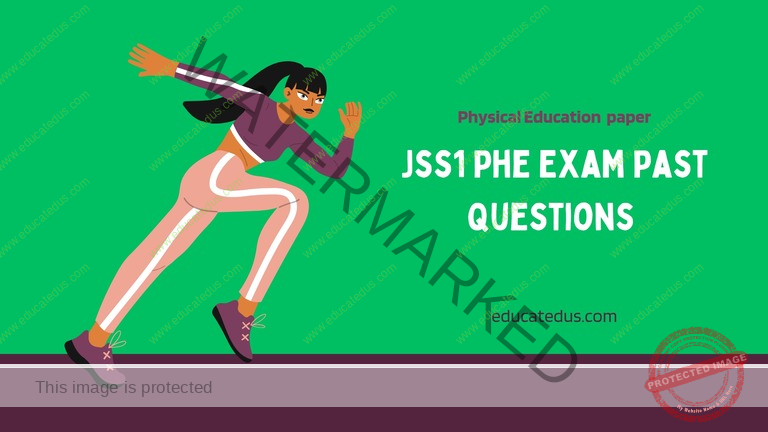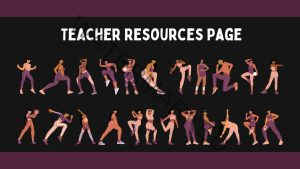JSS1 Physical and Health Education Exams Questions and Answers
Free PHE Exam Questions and Answers-JSS1

JSS1 Physical and Health Education Exams Questions and Answers: Complete solutions to objective and theory questions covering physical fitness, personal health, sewage disposal, and key PHE concepts for Junior Secondary School students. Includes detailed explanations and examples.
PHYSICAL AND HEALTH EDUCATION (PHE)
CLASS: JSS1
SECTION A: Objectives
- Corrective exercises help to remove the ____ in the body (a) energy (b) deformities (c) sweat (d) all of the above.
- Physical and health education can help students develop the ____ to live a healthy and active life (a) blood (b) height (c) skills and knowledge (d) none of the above
- One of these is not purposes of physical and health education. (a) health-related component (b) prevent diseases (c) improve mental health (d) promote health habits
- The following are the scope of physical education Except : (a) corrective exercises (b) Games and sports (C) Recreational activities (d) building confidence
- The ability to perform aspects of sports, occupations, and daily activities is known as ___ (a) physical education (b) health education (c) physical fitness (d) cardiovascular endurance.
- Components of physical fitness can be group in to two: (a) agility and co-ordination components (b) health-related and skill related components (c) flexibility and cardiovascular components (d) power and balance components.
- One of these is not examples of health related components: (a) balance (b) muscular endurance (b) body composition (c) flexibility (d) muscular strength
- One of these is not examples of skill or performance related components: (a) agility (b) power (c)coordination (d) cardiorespiratory endurance
- ____ is someone who possesses a combination of physical attributes that enable them to perform daily tasks, and sports with effective. (a) an athlete (b) sportsman (c) a physically fit person (d) none of the above
- The following are characteristics of physically fit person except: (a) has a good posture and firm physique (b) enjoys playing games and sports (c) engage in physical activity regularly (d) recovers quickly from illness.
- Some exercises that develop muscle endurance include the following except: (a) shoulder press (b) push-ups (C) sit-ups (d) running
- One of these is not basic principles of a physically fit person: (a) regular exercise (b) adaptation principle (c) nutrition (d) it improves appetite and stamina.
- Some exercises to develop muscle strength include the following except: (a) V-sits (b) bench press (c)climbing (d) squatting
- _____ is the ability of the muscles to continue to perform without fatigue: (a) flexibility (b) muscles endurance (c) muscles strength (d) personal health
- Some exercises that develop flexibility include the following except: (a) swimming (b) aerobic (c) jogging (d) stand and reach
- _____ is the ability to joints in their full normal range of motion without discomfort or pains: (a) muscular strength (b) muscular endurance (c) regular exercise (d) flexibility
- ______ is the ability of a group of muscle to generate and exert maximum force in a single effort during an activity to a point that no more repetition can be done without rest: (a) flexibility (b) muscles endurance (c) agility (d) muscles strength
- _____ involves the management of solid waste generated from household, commercial and industrial activities: (a) refuse disposal (b) sewage disposal (c) waste pollution (d) river discharge
- One of these is not key components of Sewage disposal: (a) pipes and pumps collect wastewater (b) river discharge (c) refuse (recycled water) (d) waste transportation
- One of these is not key components of Refuse disposal: (a) composing (b) landfills (c) incineration (d) sewer network
Read More: Sports Scholarship Exam: Past Questions and Expert Answer
Section B: Theory
Instruction: answer any four (4) questions
1a. Differentiate between (i) muscular endurance (ii) muscular strength and (iii) flexibility.
1b. List 4 exercises to develop (i) muscles endurance (ii) muscles strength and (iii) flexibility.
1c. Mention 5 benefits of personal health.
2a. Differentiate between Sewage and Refuse disposal. Give 3 examples each.
2b. State 3 components of sewage and refuse disposal.
2c. Mention 4 methods of sewage disposal and 4 methods of refuse disposal.
3a.What is the difference between Physical Education and Health Education?
3b.List 5 purposes of physical and health education.
3c. State 4 scope of physical and health education
4a.Who is a physically fit person?
4b.Mention 4 examples of health-related components of physical fitness and 4 examples of skill or performance related components of physical fitness.
4c. List 4 characteristics of physically fit person.
5a. Define personal health.
5b. State 4 factors affecting personal health.
5c. Mention 4 importance and 4 objectives of personal health
- Write short note on the following: (i) physical health (ii) mental health (iii) social health (iv)emotional health
7a. List 4 importance of physically fit person
7b. State 5 challenges and concerns involve sewage and refuse disposal
7c. List and explain 4 components of personal health
Exam Solutions
SECTION A: Objectives
- Corrective exercises help to remove the deformities in the body. Answer: (b) deformities
- Physical and health education can help students develop the skills and knowledge to live a healthy and active life. Answer: (c) skills and knowledge
- One of these is not purposes of physical and health education. Answer: (a) health-related component
- The following are the scope of physical education Except: Answer: (d) building confidence
- The ability to perform aspects of sports, occupations, and daily activities is known as physical fitness. Answer: (c) physical fitness
- Components of physical fitness can be grouped into two: Answer: (b) health-related and skill related components
- One of these is not examples of health related components: Answer: (a) balance
- One of these is not examples of skill or performance related components: Answer: (d) cardiorespiratory endurance
- Someone who possesses a combination of physical attributes that enable them to perform daily tasks, and sports effectively is a physically fit person. Answer: (c) a physically fit person
- The following are characteristics of physically fit person except: Answer: (d) recovers quickly from illness
- Some exercises that develop muscle endurance include the following except: Answer: (a) shoulder press
- One of these is not basic principles of a physically fit person: Answer: (d) it improves appetite and stamina
- Some exercises to develop muscle strength include the following except: Answer: (a) V-sits
- The ability of the muscles to continue to perform without fatigue is muscles endurance. Answer: (b) muscles endurance
- Some exercises that develop flexibility include the following except: Answer: (c) jogging
- The ability of joints in their full normal range of motion without discomfort or pains is flexibility. Answer: (d) flexibility
- The ability of a group of muscle to generate and exert maximum force in a single effort during an activity to a point that no more repetition can be done without rest is muscles strength. Answer: (d) muscles strength
- Management of solid waste generated from household, commercial and industrial activities is refuse disposal. Answer: (a) refuse disposal
- One of these is not key components of Sewage disposal: Answer: (c) refuse (recycled water)
- One of these is not key components of Refuse disposal: Answer: (d) sewer network

SECTION B: Theory
Question 1
1a. Differentiate between (i) muscular endurance (ii) muscular strength and (iii) flexibility.
(i) Muscular Endurance: This is the ability of muscles to perform repeated contractions against resistance for an extended period without fatigue.
(ii) Muscular Strength: This is the ability of a muscle or group of muscles to exert maximum force in a single effort or attempt to overcome resistance.
(iii) Flexibility: This is the ability of joints to move through their full range of motion without discomfort or pain.
1b. List 4 exercises to develop (i) muscles endurance (ii) muscles strength and (iii) flexibility.
(i) Exercises for Muscular Endurance:
- Push-ups
- Sit-ups
- Planks
- Running/jogging
(ii) Exercises for Muscular Strength:
- Bench press
- Squatting
- Climbing
- Weightlifting
(iii) Exercises for Flexibility:
- Stand and reach
- Swimming
- Aerobics
- Stretching exercises
1c. Mention 5 benefits of personal health.
- Increased energy levels and vitality
- Reduced risk of developing diseases
- Better quality of life and longer lifespan
- Improved mental health and reduced stress
- Enhanced physical capabilities and body function
Question 2
2a. Differentiate between Sewage and Refuse disposal. Give 3 examples each.
Sewage Disposal: This refers to the process of treating and disposing of wastewater from households, industries, and other sources. Examples:
- Septic tanks
- Sewage treatment plants
- Oxidation ponds
Refuse Disposal: This refers to the management of solid waste generated from household, commercial, and industrial activities. Examples:
- Domestic waste (food scraps, paper)
- Commercial waste (packaging materials)
- Industrial waste (manufacturing byproducts)
2b. State 3 components of sewage and refuse disposal.
Components of Sewage Disposal:
- Sewer network/collection system
- Wastewater treatment facilities
- Disposal methods (discharge, recycling)
Components of Refuse Disposal:
- Collection systems
- Transportation of waste
- Treatment and disposal methods
2c. Mention 4 methods of sewage disposal and 4 methods of refuse disposal.
Methods of Sewage Disposal:
- Primary treatment (screening, sedimentation)
- Secondary treatment (biological processes)
- Tertiary treatment (advanced filtration)
- Land application/irrigation with treated wastewater
Methods of Refuse Disposal:
- Landfilling
- Incineration
- Composting
- Recycling
Question 3
3a. What is the difference between Physical Education and Health Education?
Physical Education: This is the educational process that promotes physical activity, develops physical competence, knowledge, and behaviors for healthy active living. It focuses on developing physical fitness, motor skills, and sports abilities.
Health Education: This is the educational process that informs individuals about health-related topics such as nutrition, disease prevention, personal hygiene, and mental health. It focuses on knowledge and attitudes that promote wellness.
3b. List 5 purposes of physical and health education.
- Develop physical fitness and motor skills
- Prevent diseases through knowledge and healthy practices
- Improve mental health through stress reduction and self-confidence
- Promote healthy habits and lifestyle choices
- Foster social development through team activities and cooperation
3c. State 4 scope of physical and health education.
- Corrective exercises
- Games and sports
- Recreational activities
- Physical fitness development
Question 4
4a. Who is a physically fit person?
A physically fit person is someone who possesses a combination of physical attributes that enable them to perform daily tasks and sports effectively and efficiently without undue fatigue, while maintaining sufficient energy reserves for leisure activities and emergency situations.
4b. Mention 4 examples of health-related components of physical fitness and 4 examples of skill or performance related components of physical fitness.
Health-related components:
- Cardiovascular endurance
- Muscular strength
- Muscular endurance
- Flexibility
Skill/performance-related components:
- Agility
- Balance
- Coordination
- Power
4c. List 4 characteristics of physically fit person.
- Has a good posture and firm physique
- Engages in physical activity regularly
- Maintains healthy body weight and composition
- Enjoys playing games and sports
Question 5
5a. Define personal health.
Personal health refers to the state of physical, mental, and social well-being of an individual, achieved through proper lifestyle choices, regular exercise, balanced nutrition, adequate rest, and maintaining good hygiene practices.
5b. State 4 factors affecting personal health.
- Lifestyle choices (diet, exercise, sleep patterns)
- Environmental factors (pollution, living conditions)
- Genetic predisposition
- Access to healthcare services
5c. Mention 4 importance and 4 objectives of personal health.
Importance of Personal Health:
- Enables individuals to function effectively in daily activities
- Reduces the risk of developing chronic diseases
- Improves quality of life and longevity
- Enhances productivity and performance
Objectives of Personal Health:
- To maintain optimal physical functioning
- To prevent diseases and illnesses
- To promote mental and emotional well-being
- To achieve overall wellness and balance in life
Question 6
Write short note on the following: (i) physical health (ii) mental health (iii) social health (iv) emotional health.
(i) Physical Health: This refers to the proper functioning of the body and its systems. It involves maintaining proper nutrition, regular exercise, adequate rest, and avoiding harmful substances. Good physical health is characterized by normal body functions, physical fitness, and absence of diseases or abnormalities.
(ii) Mental Health: This is the state of well-being where an individual realizes their own potential, can cope with normal stresses of life, work productively, and contribute to their community. It includes psychological and cognitive well-being, affecting how we think, feel, and act when facing life’s situations.
(iii) Social Health: This refers to an individual’s ability to form meaningful relationships with others and interact in healthy, positive ways. It includes communication skills, creating and maintaining relationships, and being able to adapt in social situations. Good social health enables one to build a support network that helps during challenging times.
(iv) Emotional Health: This involves the awareness, understanding, and acceptance of feelings, and the ability to manage emotions effectively. It includes coping with stress, building resilience, maintaining a positive outlook, and having self-esteem. Emotionally healthy individuals can express their feelings appropriately and handle life’s challenges.
Question 7
7a. List 4 importance of physically fit person.
- Has greater energy and stamina for daily activities
- Experiences reduced risk of chronic diseases like diabetes and heart disease
- Maintains better mental health and cognitive function
- Recovers more quickly from injuries and illnesses
7b. State 5 challenges and concerns involve sewage and refuse disposal.
- Environmental pollution (water, soil, air)
- Spread of diseases and health hazards
- Limited disposal facilities and infrastructure
- High costs of proper disposal systems
- Public resistance to disposal facilities (NIMBY – Not In My Back Yard syndrome)
7c. List and explain 4 components of personal health.
- Physical Health: Involves maintaining proper bodily functions through regular exercise, balanced nutrition, adequate rest, and avoiding harmful substances. Good physical health is characterized by normal body functions and absence of diseases.
- Mental Health: Refers to psychological and cognitive well-being that affects how we think, feel, and behave. It includes the ability to manage stress, maintain positive relationships, and make good life choices.
- Social Health: Involves the ability to form meaningful connections with others and interact in healthy, positive ways. Good social health enables building supportive relationships and functioning effectively in society.
- Emotional Health: Encompasses awareness and acceptance of feelings and the ability to express emotions in a constructive manner. It includes coping mechanisms, resilience, and maintaining a positive outlook on life.
REFERENCES
- Nigeria Educational Research and Development Council (NERDC) – JSS Curriculum URL: https://nerdc.org.ng/eCurriculum/JSS/PhysicalEducation.pdf This is the official curriculum guide that these exam questions are based on, containing the approved content for Physical and Health Education for Junior Secondary Schools in Nigeria.
- World Health Organization (WHO) – Physical Activity URL: https://www.who.int/news-room/fact-sheets/detail/physical-activity Referenced in questions about physical fitness, health benefits, and components of physical wellbeing.
- Federal Ministry of Education, Nigeria – Basic Education Resources URL: https://education.gov.ng/resources/basic-education/ Contains official educational resources that align with the JSS curriculum standards reflected in these exam questions.

